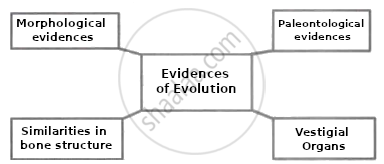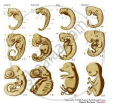Advertisements
Advertisements
प्रश्न
Complete the following chart:

उत्तर

APPEARS IN
संबंधित प्रश्न
(a) Select the homologous structures from the combinations given below:
(i) Forelimbs of whales and bats
(ii) Tuber of potato and sweet potato
(iii) Eyes of octopus and mammals
(iv) Thorns of Bougainvillea and tendrils of Cucurbita
(b) State the kind of evolution they represent.
“Two areas of study namely 'evolution' and 'classification' are interlinked'. Justify this statement.
Which of the following is a correct set of homologous organs?
(a) Forelimbs of frog, bird and lizard
(b) Spine of cactus and thorn of bougainvillea
(c) Wings of bat and wings of butterfly
(d) Wings of a bird and wings of a bat
Enlist any four sequential evolutionary names of human ancestors.
Explain the evolution of giraffe's neck according to Lamarck's theory of evolution.
What are homologous organs?
Human tailbone is a vestigial organ. Explain.
One pair of organs in the following animals are not homologous. This is :
(a) forelimbs in humans and lizard
(b) forelimbs in lizard and frog
(c) wings in butterfly and bat
(d) wings in bat and bird
You have potato, carrot, radish, sweet potato, tomato and ginger bought from the market in your jute bag. Identify two vegetables to represent the correct homologous structures.
(A) Potato and tomato
(B) Carrot and tomato
(C) Potato and sweet potato
(D) Carrot and radish
What do we call the degenerated or partially developed useless organs in living organisms? Enlist such organs in human body? How the same organs are useful in other animals?
Explain with suitable examples importance of anatomical evidence in evolution.
Observe the picture and answer the following questions.
A) Which evidence of evolution is shown in the picture?
B) What can be proven with this proof?
C) Give one more example of evidence of evolution
Answer the following question.
Wisdom teeth : Vestigial organs :: Lungfish : ....................
Define phylogeny.
Very short answer question.
What are homologous organs?
Short answer question.
Give the significance of fossils.
_____________ is a vestigial organ in human beings.
I am a connecting link between reptiles and mammals. Who am I?
The decaying process of C-14 occurs continuously in dead organisms only.
Give scientific reason.
Vertebrates have slowly originated from invertebrates.
Write a short note:
Embryological evidences
Complete the flowchart.

Observe the given images and answer the following questions.

- Which evolutionary evidence does it indicate?
- What does it prove?
- State another example of evolutionary evidence.
Where is carbon dating used?
- Define vestigial organs.
- Write names of any two vestigial organs in the human body.
- Write name of those animals in which these vestigial organs are functional.
Palaeontological evidence for evolution refers to the ______.
Fossils are generally found in ______.
Did aquatic life forms get fossilised? If, yes where do we come across such fossils?
How do we compute the age of a living tree?
While creation and presence of variation is directionless, natural selection is directional as it is in the context of adaptation. Comment.
Explain divergent evolution in detail. What is the driving force behind it?
I am the connecting link of annelida and arthropoda. What is my name?
Give a scientific reason.
Morphological evidences suggest that dog, sheep and wolf have a common origin.
Explain natural selection with the example of industrial melanism.
Write a note on the significance of Palaeontology.
Give examples of homologous organs and analogous organs in plants.
Pick the odd man out:
